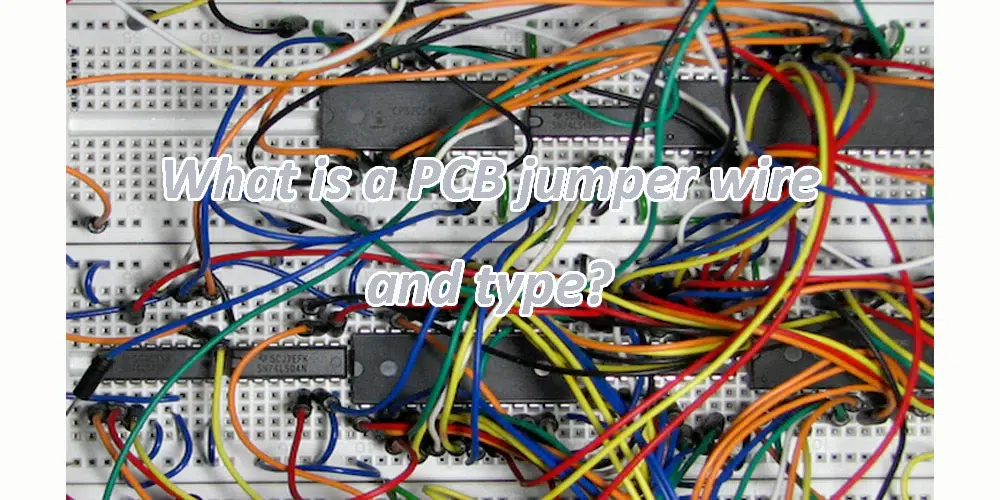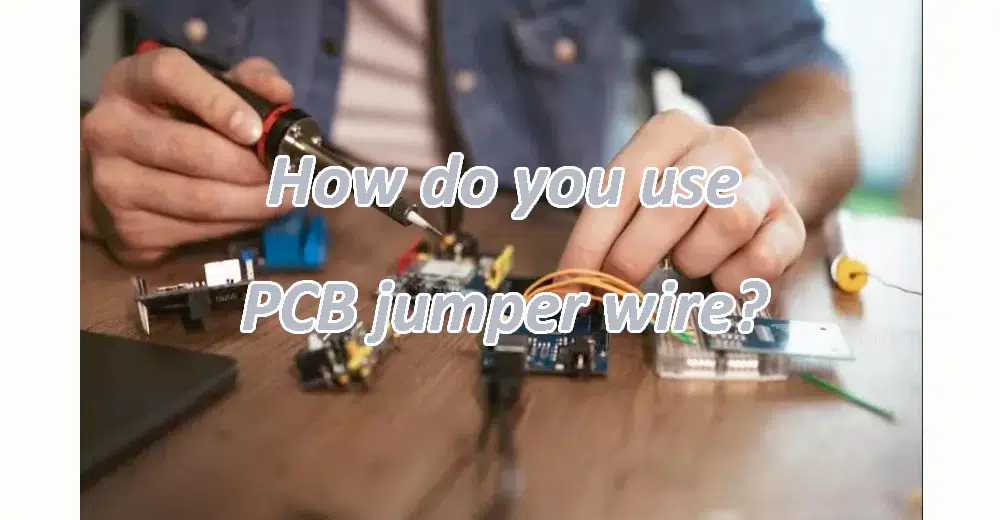In the realm of electronics prototyping and circuit design, efficiency and flexibility are paramount. Enter the humble yet indispensable PCB jumper wires – a versatile component that bridges connections, enables rapid iterations, and facilitates seamless experimentation in electronic projects. In this comprehensive exploration, we delve into the intricacies of PCB jumper wires.
What is a PCB jumper wire ?
PCB jumper wires, often referred to simply as jumpers, are small conductive wires used to establish electrical connections between different points on a printed circuit board. These wires are typically insulated with a thin layer of plastic or polymer, leaving only the metal conductor exposed at the ends. They come in various lengths, gauges, and colors to suit different circuit layouts and design requirements.
Jumper wires are typically small gauge wires that are soldered onto the PCB surface. They come in various colors to help distinguish between different connections, and they can be insulated or bare depending on the specific application and environmental factors.
While PCB jumper wires are a useful tool for making temporary or small-scale modifications to a PCB, they are not typically used in production-grade PCBs due to their manual nature and the potential for reliability issues over time. Instead, designers strive to create PCB layouts that minimize the need for jumper wires and ensure robust and reliable electrical connections.
What are the types of PCB jumper wires?
PCB jumper wires come in various types depending on their application and construction. Here are some common types:
1. Pre-cut Jumpers: These are pre-cut wires with insulation removed at both ends, ready to be soldered onto the PCB pads or through-holes.
2. Jumper Headers: These are typically small plastic blocks with metal pins that can be inserted into a PCB header socket. They allow for easy connection and disconnection, making them useful for testing and prototyping.
3. Wire Wraps: These are thin wires wrapped around a post or pin to form a connection. They are commonly used in prototyping or for making temporary connections.
4. Surface Mount Jumpers: These are small metal or conductive polymer components that are soldered directly onto the surface of the PCB. They are often used to bridge traces or connections on the PCB.
5. Zero Ohm Resistors: These are essentially resistors with zero resistance, acting as jumpers to connect traces on the PCB. They are often used when the space is limited, and a jumper wire won’t fit.
6. Solder Bridges: In some cases, a simple solder bridge, where solder is applied directly between two points on the PCB, can act as a jumper wire.
Each type has its advantages and is chosen based on factors such as space constraints, ease of installation, and intended use.
What’s the role of Jumper Wires in electronics prototyping?
Breadboarding: One of the primary applications of PCB jumper wires is in breadboarding – the process of prototyping electronic circuits using a breadboard. Jumper wires enable engineers, hobbyists, and students to quickly and easily create connections between components without the need for soldering, facilitating rapid experimentation and testing.
Circuit Debugging: When troubleshooting a circuit, jumper wires play a crucial role in isolating faulty components or connections. By selectively bypassing suspect elements with PCB jumper wires, designers can pinpoint issues and refine their designs effectively.
Custom Modifications: PCB jumper wires offer unparalleled flexibility in modifying existing circuits or adapting designs to meet specific requirements. Whether adding new components, altering connections, or implementing last-minute changes, jumpers provide a convenient solution for on-the-fly adjustments.
Prototype Flexibility: Prototyping often involves testing multiple iterations of a design. Jumper wires allow for quick reconfiguration of circuits, facilitating rapid prototyping cycles and accelerating the development process.
What is a PCB jumper wire used for?
A PCB jumper wire is used to establish an electrical connection between two points on a PCB. This connection might be necessary for various reasons:
1. Trace Repair: If there’s a defect in a PCB trace (the conductive pathways on the board), a jumper wire can be used to bypass the damaged area and restore connectivity.
2. Signal Routing: In some cases, the original PCB layout might not have included a direct connection between two components or points that need to communicate electrically. A jumper wire can bridge this gap.
3. Component Modification or Replacement: If a circuit design needs to be modified, or if a component needs to be replaced with one having different pin configurations, jumper wires can reroute connections accordingly.
4. Customization: PCB Jumper wires allow engineers to customize the electrical connections on a PCB to meet specific requirements or optimize circuit performance.
5. Prototyping and Testing: During the development phase of a circuit, jumper wires are often used for quick testing and prototyping, enabling rapid modifications without the need for redesigning the entire PCB.
6. Configuration Changes: In some circuits, especially those involving jumpers or switches for configuration settings, jumper wires can be used to set or change these configurations as needed.
Overall, PCB jumper wires serve as versatile tools for modifying, repairing, customizing, and testing electronic circuits, offering flexibility and adaptability in various scenarios.
How do you use PCB jumper wires?
Soldering jumper wires to a circuit board is a common practice in electronics assembly and repair. Here’s a step-by-step guide on how to solder jumper wires effectively:
### Materials Needed:
1. Jumper wires
2. Circuit board
3. Soldering iron
4. Solder
5. Flux (optional, but recommended)
6. Soldering flux pen or flux applicator (if not using flux core solder)
### Steps:
1. **Prepare the Circuit Board:**
– Ensure the circuit board is clean and free from any debris, oxidation, or contamination. You can clean the board using isopropyl alcohol and a lint-free cloth.
2. **Prepare the PCB Jumper Wires:**
– Cut the jumper wires to the desired length, ensuring they are long enough to make the necessary connections but not too long to cause interference or strain on the board.
– Strip a small amount of insulation (usually about 1/8 inch or 3 mm) from each end of the jumper wires using wire strippers.
3. **Tinning the Wires:**
– Apply a small amount of solder to the exposed copper wire ends. This process, known as “tinning,” helps to prevent oxidation and makes it easier to solder the wires to the circuit board later.
4. **Prepare the Soldering Iron:**
– Turn on your soldering iron and allow it to heat up to the appropriate temperature for soldering electronic components (typically between 300°C to 400°C or 572°F to 752°F).
– Clean the soldering iron tip using a damp sponge or brass wire tip cleaner to ensure it is free from oxidation and debris.
5. **Apply Flux (Optional):**
– Apply a small amount of flux to the solder pads on the circuit board where you will be soldering the jumper wires. Flux helps to improve solder flow and wetting, resulting in stronger and more reliable solder joints.
6. **Solder the PCB Jumper Wires:**
– Place the tinned end of the jumper wire onto the solder pad on the circuit board, ensuring it aligns correctly with the intended connection point.
– Hold the soldering iron tip against the exposed wire end and the solder pad on the circuit board simultaneously.
– Allow the solder to melt and flow onto the joint, creating a secure bond between the wire and the pad.
– Remove the soldering iron and hold the wire in place until the solder cools and solidifies, forming a strong connection.
– Repeat this process for each jumper wire connection, ensuring proper alignment and spacing between wires to avoid short circuits.
7. **Inspect and Test:**
– Once all jumper wires are soldered in place, visually inspect each solder joint to ensure they are shiny, smooth, and free from cold solder joints or other defects.
– Test the continuity and functionality of the connections using a multimeter or other appropriate testing equipment to verify that the circuit operates as intended.
8. **Trim Excess Wire (Optional):**
– If desired, trim any excess length of jumper wire using wire cutters or flush cutters to improve the appearance and minimize the risk of interference with nearby components or circuitry.
What is the difference between male and female jumper wires?
Male and female jumper wires refer to the types of connectors or ends that are present on the wires. Here’s the difference between the two:
1. Male Jumper Wires:
– Male jumper wires have pins or protrusions at one end, resembling a male connector.
– These pins are designed to be inserted into female connectors, such as headers or sockets on a circuit board or breadboard.
– Male jumper wires are typically used to make connections from components or devices to the circuit board or breadboard.
2. Female Jumper Wires:
– Female jumper wires have sockets or receptacles at one end, resembling a female connector.
– These sockets are designed to receive male connectors, such as pins or headers on a circuit board or components.
– Female jumper wires are often used to create extension cables or connections between components, boards, or modules.
In summary, the main difference between male and female jumper wires lies in the type of connectors present at the ends of the wires. Male jumper wires have pins for insertion into female connectors, while female jumper wires have sockets for receiving male connectors. Both types of jumper wires are essential for making connections in electronic circuits, prototyping, and testing.
What is jumper wire connector?
A jumper wire connector is a component used in electronics to make connections between various points on a circuit board or a breadboard. These connectors come in various forms, but they generally consist of a housing or socket that accommodates the connection of a jumper wire. The jumper wire itself is typically a short length of insulated wire with connectors or pins at each end.
Jumper wire connectors are often used in breadboarding and prototyping scenarios where circuits need to be easily assembled, disassembled, or modified. They allow for quick and temporary connections between different components, enabling rapid testing and iteration of electronic circuits without the need for soldering.
These connectors can come in different shapes, sizes, and configurations depending on the specific application and requirements of the circuit being built. Some common types include male-to-male, male-to-female, and female-to-female connectors, each serving different purposes in making specific types of connections.

What are breadboard jumper wires?
Breadboard jumper wires are specially designed wires used for making connections on a breadboard, a prototyping tool commonly used in electronics. These wires are flexible and come in various lengths, typically with pre-crimped connectors at both ends. They are used to create temporary connections between the components, integrated circuits (ICs), and other elements placed on the breadboard.
Conclusion
In the dynamic world of electronics prototyping, PCB jumper wires emerge as indispensable tools, empowering designers, engineers, and hobbyists to bring their ideas to life with speed, precision, and creativity. From breadboarding and circuit debugging to rapid iteration and custom modifications, jumper wires offer a versatile and efficient solution for realizing innovative electronic designs. As technology advances and new challenges emerge, the enduring utility of PCB jumper wires continues to drive progress and innovation in the field of electronics prototyping.
PCB jumper wires, often referred to simply as jumpers, are small conductive wires used to establish electrical connections between different points on a printed circuit board.
Pre-cut Jumpers
Jumper Headers
Wire Wraps
Surface Mount Jumpers
Zero Ohm Resistors
Solder Bridges
Trace Repair
Signal Routing
Component Modification or Replacement
Customization
Prototyping and Testing
Configuration Changes












